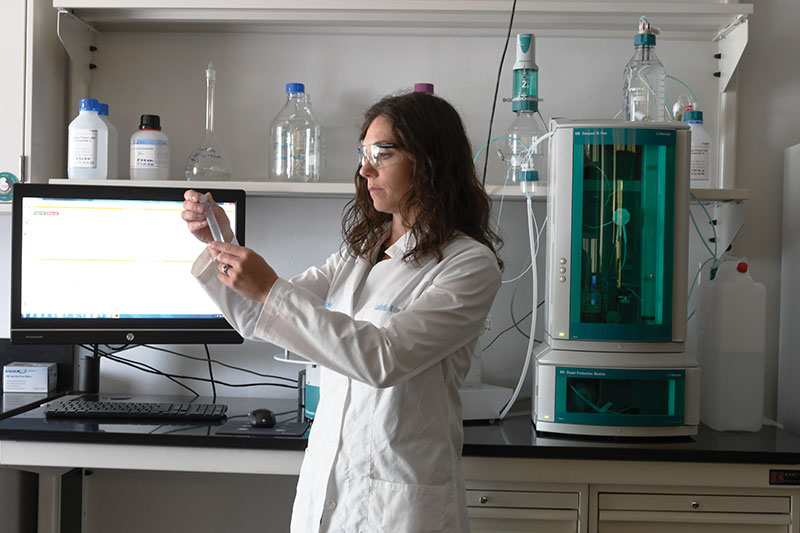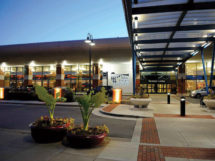UTILITIES

A new customer portal, water meters that use an advanced infrastructure network and an enhanced billing system are part of Louisville Water Co.’s three-year program to improve customer experience.
The “Pure Connect” project, which launches in late 2020, is one of the ways the water company is using new technology to provide better service. A software platform and new meters are at the core of the project, said Kelley Dearing Smith, Louisville Water’s vice president of communications and marketing.
 The new meters, which will take three years to install, capture water usage on an hourly basis and send the information to the company, she said. Customers can view their water usage on the new customer portal. The data will help both customers and Louisville Water employees spot water leaks or other abnormalities in usage. With the new meters, all customers will be switched to monthly billing instead of bi-monthly, which is easier for both customers and the utility, Smith said.
The new meters, which will take three years to install, capture water usage on an hourly basis and send the information to the company, she said. Customers can view their water usage on the new customer portal. The data will help both customers and Louisville Water employees spot water leaks or other abnormalities in usage. With the new meters, all customers will be switched to monthly billing instead of bi-monthly, which is easier for both customers and the utility, Smith said.
Louisville Water Co. embarked on the $60 million project – the most extensive customer service project it has ever undertaken – just months after completing the largest water main replacement project in its 160-year history. After four years of construction with dozens of lane closures and detours, Louisville Water in May completed the “Eastern Parkway Project,” replacing 6.4 miles of water main that stretch along Eastern Parkway and Lexington Road, two of the city’s busiest areas.
The pipe, a 4-foot-diameter water main, was installed in the early 1900s and sits underneath and along busy highways and thriving neighborhoods. Instead of digging up highways and removing the old pipe, Louisville Water used a technology called “slip-lining,” where crews kept the old pipe in the ground and pushed a new, smaller pipe inside the original 48-inch pipe. This method preserved the character of the Eastern Parkway corridor. Because Louisville Water has a redundant system and can use multiple water mains to deliver water, customers did not lose water service during the project.
Louisville Water started the Eastern Parkway Project in 2016, nearly 100 years after the main was put in the ground. After three large breaks in 2011 and 2014, robotic pipe inspections indicated the pipe would likely continue to break. Working with the community and engineers, the company developed a solution that would install a new water main and preserve the character of the historic Eastern Parkway corridor. Since 2016, the project has included more than 20 different traffic lane closures and detours. The project cost $26 million and was funded through Louisville Water’s capital budget.
- IT’S FREE | Sign up for The Lane Report email business newsletter. Receive breaking Kentucky business news and updates daily. Click here to sign up
With the Ohio River as the source, Louisville Water has access to 75 billion gallons of water flow each day. Its reserve treatment capacity can supply 35 auto manufacturing plants, and it can double its production almost overnight.
Louisville Water’s footprint includes more than 1,000 square miles in Louisville Metro and six surrounding counties, including nine other water utilities that purchase drinking water from Louisville Water and then deliver it to their customers. Its customer base includes more than 1 million people, with more than 22,000 business customers and 244,000 residential homes. The utility’s rates are more affordable than those in peer cities, and large-volume users have access to special rates. Regional water sales were predicted to produce an estimated $6.6 million in 2020.
The utility often is recognized as a leader for water quality and innovation. In fact, the filtration process that many water utilities use to produce drinking water was pioneered at Louisville Water in 1896, Smith said.
Louisville Water was the first, and so far only, utility to trademark tap water. In 1997, the water was named “Louisville pure tap” to highlight its value and quality, she said.
“Our treatment plants rank as two of the top 18 in North America for outstanding water quality. To get this status, a utility must go above and beyond in meeting the regulatory standards. There are 55,000 public water systems in the U.S.,” Smith said.
Every day, Louisville Water conducts hundreds of tests in its Environmental Protection Agency-certified laboratory to ensure the quality and safety of its drinking water.
“We’ve had great-tasting water and a progressive water utility for so long, we almost take it for granted. Many cities, however, are extremely envious, to say the least, of both the quality and quantity of our water supply,” said Louisville Mayor Greg Fischer. “It’s a huge part of what makes Louisville a great place to live as well as grow a business, because companies know that they can count on a constant, affordable supply of water.”
Louisville Water focuses on tap water taste, Smith said.
“A taste test is one of the 200-plus water quality experiments we do every day on the drinking water,” she said. “We’re building on this rich history and status with ongoing research and innovation. In our EPA certified lab, we’re looking at emerging contaminants and how to best manage that. We’re also researching new treatment technologies to account for how quickly the science of drinking water evolves.”
LG&E/KU adapts during pandemic, continues to invest in community
In response to the global pandemic, LG&E and KU Energy adjusted how it does business, striving to make “prudent, thoughtful decisions,” said Paul W. Thompson, chairman, CEO and president of LG&E and KU Energy.
Based in Louisville, LG&E serves nearly 329,000 natural gas and 418,000 electric customers in Louisville and 15 surrounding counties. It has 6,544 miles of electric distribution and 4,755 miles of gas transmission and distribution.
LG&E modified schedules and processes, prioritized safety, and focused on the health and well-being of its employees while continuing to provide uninterrupted service to its customers, Thompson said.
From March to June, the company saw a 15 to 20% reduction in usage by commercial and industrial customers who scaled back operations or shut down. That was partially offset by a 5% increase in residential usage, he said. During that time, the utility relaxed some of its policies and extended assistance to customers, and its foundation increased support to nonprofits and civic organizations, donating more than $250,000 to COVID-10 relief efforts.
“As the state’s largest electric and natural gas utilities, we’re 100% behind our customers and our great commonwealth,” Thompson said. “We’ll all be working hard to overcome the effects from this global pandemic and get our communities back on their feet again.”
LG&E’s leadership is preparing for new prospects that may come to Kentucky because of business community shift, he said.
“For example, we’ve been working with our communities to evaluate the possibility of new industrial and commercial sites throughout our service territory while also helping to evaluate existing sites to determine if additional investment may increase exposure to our communities,” Thompson said. “In addition, we’re developing a grant program to incentivize communities to make proactive investments in product readiness and development.”
LG&E and KU have more than 3,500 employees, and it purchases goods and services in 91 Kentucky counties. In 2019, Site Selection magazine named LG&E and KU among the top 20 utilities in the United States for corporate facility investment and job creation.
“We strive to bring growth and expansion to the territories we serve, and it’s a tremendous honor to be recognized for our dedication to helping empower economic prosperity,” said Beth McFarland, LG&E/KU vice president of customer services. “Driving economic development not only helps the success of new and expanding businesses, but ultimately enhances the quality of life for the communities where we live, work and raise our families.”
Site Selection recognized LG&E/KU for investing $2.2 billion in infrastructure improvements to benefit existing and future customers and helping create more than 7,500 jobs. LG&E/KU also made upgrades to two hydroelectric plants, provided nearly $1.5 million in economic development demand credits through the companies’ Economic Development Rider program, and gave business and industrial customers the opportunity to invest in local solar energy and receive monthly credits through its Business Solar and Solar Share programs.
LG&E’s technology and research analysis team investigates and evaluates new technology to find ways of better serving customers, and takes part in collaborative studies to minimize costs. The company’s research is, in part, aimed at investigating technologies that will reduce the cost of capital, operations and maintenance at its power plants, transmission and distribution systems.
The research team also looks for ways to improve safety and reliability, including energy storage technologies, educating power engineers for a future distribution grid, robotic technologies, and minimizing environmental impact.
LG&E and KU Energy LLC
220 W. Main St.
Louisville, KY 40202
(800) 981-0600
Consistently ranked among the best companies for customer service in the United States and recognized eight times as one of the top utilities in the country for economic development by international economic development magazine Site Selection, Louisville Gas and Electric Co. and Kentucky Utilities Co. are committed to attracting and keeping businesses in the Bluegrass and making the commonwealth a better place to live.
As the energy landscape continues to evolve, LG&E and KU are evolving with it. The utilities continue to create programs and offerings to help meet the goals of business and residential customers – including opportunities to support and grow renewable energy and installing publicly accessible charging stations to support electric vehicle adoption. Comprised of coal, natural gas, hydroelectric and solar, LG&E and KU maintains a diverse generation mix and rates that are among the lowest in the nation.
Louisville Water Company
550 S. Third St.
Louisville, KY 40202
(502) 583-6610
Louisville Water provides a high-quality, reliable supply of drinking water to Louisville Metro and portions of Bullitt, Hardin, Nelson, Oldham, Shelby and Spencer counties. Louisville Water began as Kentucky’s first public water provider in 1860 and today its treatment plants are ranked as two of the top 18 in North America for outstanding water quality.




















Add Comment